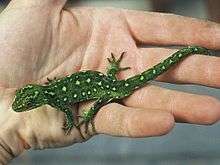West Coast green gecko
| West Coast green gecko | |
|---|---|
 | |
| Scientific classification | |
| Kingdom: | Animalia |
| Phylum: | Chordata |
| Class: | Reptilia |
| Order: | Squamata |
| Family: | Diplodactylidae |
| Genus: | Naultinus |
| Species: | N. tuberculatus |
| Binomial name | |
| Naultinus tuberculatus (McCann, 1955) | |
| Synonyms | |
| |
The West Coast green gecko, Lewis Pass green gecko, or warty tree gecko (Naultinus tuberculatus) is a species of the family Gekkonidae (gecko).
Distribution
The West Coast green gecko is endemic to New Zealand, found only at Lewis Pass, Rahu, Reefton, and northern Westland, in the South Island.
Habitat
Curbing and divings, occupying the canopy area of manuka and kanuka in particular.
Description
This gecko has a "mossy" appearance due to the complex patterns of white and yellow shades on the background green coloration of the body. The mouth lining is blue, and the tongue is an orange-pink. The toes, which are yellow or yellowish-green, are narrow and tapering. There is usually a small spot of bright yellow at the corners of the mouth.
Length can reach 85 mm, snout to vent.
Ecology
This gecko is diurnal and arboreal. Young are born between March and May, and have more conspicuous markings than the adults.
Reproduction is viviparous.
Conservation status
As of 2012 the Department of Conservation (DOC) classified the West Coast green gecko as Nationally Vulnerable under the New Zealand Threat Classification System.[1]
References
- 1 2 Hitchmough, Rod; Anderson, Peter; Barr, Ben; Monks, Jo; Lettink, Marieke; Reardon, James; Tocher, Mandy; Whitaker, Tony. "Conservation status of New Zealand reptiles, 2012" (PDF). Department of Conservation. The Government of New Zealand. Retrieved 18 July 2015.
External links
| Wikispecies has information related to Naultinus tuberculatus |
